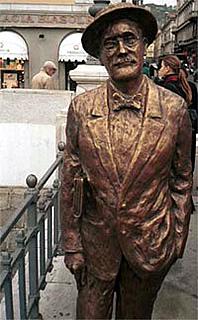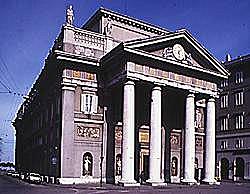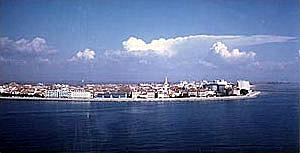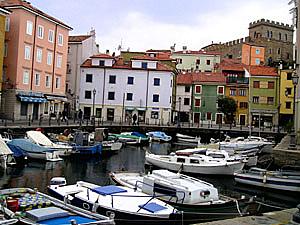A restaurant in north east China was closed down for listing stir fried tiger meat with peppers for US $98 or a kilo of tiger meat for US $ 863. Maybe it was the fact that the sale of tiger meat is outlawed in China or that the restaurant was less than a mile away from a Siberian Tiger Park that attracted the attention of local authorities. Police raided the restaurant to find that actually the tiger meat was donkey marinated in tiger urine – to give it “a special flavour”. Hhhmm, nice.
Category Archives: enewsletter
European Airline Delays
According to a recent study, some 30% of European flights from London Heathrow were delayed in 2004.
The average delay per flight was 33 minutes. Zurich and Vienna were the second and third most affected at 26% and 24% respectively.
The lowest number of delays was reported at Oslo, where 13% of flights were delayed more than 15 minutes, with an average delay of 38.5 minutes. Helsinki, Brussels and Copenhagen airports also reported low delays.
Worst airline performer in the survey was Turkish Airlines with 100% of flights delayed out of Paris Charles de Gaulle, with an average delay of 428 minutes
Meeting News from Ontario
For information on Ontario meetings, please contact Svatka Hermanek: shermanek@schulich.yorku.ca or Bruce Weber: tel. 416-203-0911 or Paul Webb: tel. 416-694-8259.
Meetings are held on the third Friday of January, March, May, September and November. Usually at the Woodsworth Co-op, Penthouse, 133, Wilton Street in downtown Toronto at 8.00 p.m.
Singapore Giant Ferris
Singapore is following London's lead and plans to build a giant Ferris wheel. Designers estimate that it will be 142 feet taller than the London Eye and say that visitors will be able to enjoy views of neighbouring Malaysia and Indonesia from the 587ft-high wheel when it is completed in early 2008.
Satellite Photo
Spotted by Webmaster Paul, here's a satellite photo from Google of the Stonehenge
Greg McKenzie's Motorbike Travels from Rio Gallegos to Ushuaia
 Trip duration: 19 days
Trip duration: 19 days
Trip miles to date: 3,040
Miles since last update: 1,023
I've recently arrived in Peurto Natalès having successfully visited Ushuaia and the end-of-the-world!!! Having hoped to make Ushuaia in a single leap from Rio Gallegos, I had to overnight in Rio Grande (150 miles short) as 2 border crossings and a delayed ferry crossing (across the Straights of Magellan) slowed progress.
The borders were remarkably trouble-free and I'm thankful for getting the correct documentation (Carnet de Passage for the bike) prior to travelling. It's also a bonus that many bikers come through these borders on route to Ushuaia so the officials know what they're looking at – although I'm still impressed with the flamboyance and enthusiasm you can put into stamping a document 6 or 12 times.

Any thoughts of reaching Ushuaia that night were dashed at the ferry crossing at Pta. Delgardo, which connects mainland Chile with Terra del Fuego. Even by Pategonian standards, it was pretty bloody windy that day and the ferry ramp on the other side was closed. I joined a long-line of traffic and had to park the bike behind other vehicles to prevent it from being blown over!
With little information forthcoming, many vehicles turned around and headed south (I guess) to Punta Arenas and the longer ferry crossing. The other frustration was that trucks and coaches automatically drove to the head of the queue, taking priority over the proletariat like me. Of course everybody else could take shelter in their cars / vans / 4×4's etc – but for me it was a couple of hours sitting on the tarmac in the lee of the wind.
 Eventually, 3 hours after arriving,
I got to board a ferry. Naturally I was pulled aside and
loaded last, squeezed on between a rental car and the now raised
loading ramp. I didn't share the loaders confidence in
the position of the bike so I decided to stay on the bike for the
incredibly bumpy 20 minutes it took to cross – if I hadn't
the bike would have fallen against the car for sure.
Eventually, 3 hours after arriving,
I got to board a ferry. Naturally I was pulled aside and
loaded last, squeezed on between a rental car and the now raised
loading ramp. I didn't share the loaders confidence in
the position of the bike so I decided to stay on the bike for the
incredibly bumpy 20 minutes it took to cross – if I hadn't
the bike would have fallen against the car for sure.
The blast down to San Sebastian (2nd border) was fun as it was dirt road all the way and I was able to catch, and pass all the traffic from both the ferry I was on, and the previous ferry that was full of vehicles that had driven past me in the queue (very satisfying!!!)
After over-nighting in Rio Grande I struck out for Ushuaia the next day. Pleasingly the terrain changed from the flat open pampas to forested mountains. The last 20 miles changed from dirt track to beautiful tarmac, which wouldn't have been out of place along the Route Napoleon outside Nice.
Eventually I rounded a corner and there it was – USHUAIA!!! It amuses me that after 2,000 miles this marks the start of my stated trip to Alaska.

From the gentle slope down into the town, I could see several ships in port ahead. Little did I appreciate what this really meant. Upon parking on the high street in search of a hotel list I was immediately approached by several Brit tourists – drawn by the Union Jack on my crash helmet. This was pleasant enough but it highlights the type of town Ushuaia is, a transit lounge for wealthy western tourists on route to a short trip around Antarctica. Ushuaia was quite unlike any other town in Argentina, full of tacky souvenir shops, Irish theme pubs and expensive hotels.
After spending a night at the (very welcoming) Hostel Albergue I decided to get out of town, choosing to camp in the remarkably picturesque Nation Park of Terra del Fuego, which coincidentally also contains the official end of the road.
I dutifully posed for the obligatory photo next to the wooden
marker (see below) before setting up camp (first time
on the trip). The park is stunning and the following day I set
off early to climb the highest peak there (yeah, a bit foolhardy
I know). The trails were easy to follow but the climb was a
tricky one, rising through incredibly dense forest, sat points
resembling something out of Hansel & Gretal, into peat bog
and eventually a tall slope of loose scree.
before setting up camp (first time
on the trip). The park is stunning and the following day I set
off early to climb the highest peak there (yeah, a bit foolhardy
I know). The trails were easy to follow but the climb was a
tricky one, rising through incredibly dense forest, sat points
resembling something out of Hansel & Gretal, into peat bog
and eventually a tall slope of loose scree.
The summit view was worth the toil (photo above) showing all around the Beagle Channel and off into Chile and Cape Horn itself.
Next day I set off north, aiming to stop in Punta Arenas. Another border, another ferry across the Magellan Straights, and once more I'm in Chile. At the ferry ramp at Porvenir I was entertained by 10 Czech engineers on route to James Ross Island to build the Czech Republic's first research station in Antarctica. Amusingly they were more impressed at my trip than their own forthcoming endeavour, but having just read about the fateful trip of Shackleton's expedition to that area, I'm in awe of anybody who elects to spend a lengthy stay there. One of them had contacts with the Czech version of Motorcycle News (magazine) and took my details and a photo for the journal.
So now I'm in Peurto Natales and about to embark on a 6 day trek around the Torres del Paine national park. This was a must do excursion for me before the trip and from what I can see of the Andes rising from the horizon, I wont be disappointed.
I'm 3,000 miles and 20 days into this trip and getting used to the change of lifestyle. What I have noticed is the western-world (and specifically US) 'culture-creep'. Every hotel I check into has 60 channels of TV with predominately US content spilling out and it inevitably impacts the local environment.
I wonder what this trip would find if it were repeated 50 years from now.
If you want to know more about Greg's travels, visit his website at: http://www.unbeatentrack.com/
Protect against Malaria
Campaigners organising Malaria Awareness Week say that British tourists are too complacent about contracting malaria as they travel to more and more far flung locations. In particular, last minute bargain hunters are at risk because they don't leave time to arrange medication. Last year around 5m travelled to risk areas, but 60% did not take the right health advice before they set out. Around 2,000 Britons get malaria each year, and deaths are low but rising.
"Failed States" Warning
Recent research from the United States publication Foreign Policy and the US NGO “Fund for Peace” has identified the twenty most vulnerable countries as: Ivory Coast, Congo, Sudan, Iraq, Somalia, Sierra Leone, Chad, Yemen, Liberia, Haiti, Afghanistan, Rwanda, North Korea, Colombia, Zimbabwe, Guinea, Bangladesh, Burundi, Dominican Republic and Central African Republic. Ten Latin American countries out of the list of sixty that run the risk of becoming what is described as “failed states” are: Haiti, Colombia, Dominican Republic, Venezuela, Guatemala, Paraguay, Peru and Honduras.
The “failed states” ranking is based on twelve economic, social, political and military performance indicators. Other organisations have different views. The World Bank has identified about 30 “low-income countries under stress”; the UK's Department for International Development has named 46 “fragile” states of concern. A report commissioned by the CIA has put the number of failing states at about 20.
Destination Guide – Trieste by Karen Bryan
Trieste is an Adriatic coastal city in north eastern Italy, close to the border with Slovenia. The sea in the Gulf of Trieste is very clear and clean, with limestone cliffs and rocky beaches. The centre of the city has a mid-European feel, more Austrian than Italian, Trieste was the seaport of the Hapsburg Empire. Here you can enjoy a combination of a sea/beach holiday and the attractions of a cultural city.
It is an ideal destination for a short break but you could easily spend a week here. The Verdi Theatre hosts an opera season in the winter and an operetta festival in summer. You can swim in the beautiful clear sea, stroll the promenade, and walk along the cliff paths. Take in the wonderful art collection at the Revoltella Museum. You can sip coffee on Piazza Unita Italia with its grand 19th century buildings, which face onto the sea.
History: according to folklore, Trieste was founded by Tergeste, a friend of Jason and the Argonauts. Ancient Tergeste as a Roman colony is dated to around 178 BC. It became more important during the reign of Octavian when roads were improved. The city has had many rulers during its history: Goths, Byzantines, and Lombards. In the 13th century Trieste was forced to swear allegiance to Venice. To escape Venetian domination, Trieste sought the protection of Duke Leopold of Austria. Trieste was of great importance to the Hapsburg Empire as a seaport and was made a Freeport in 1719. Without customs barriers the port and city flourished. At the end of the First World War with collapse of the Hapsburg Empire, Trieste was returned to Italy in 1918. Trieste was taken over by the Third Riech when Italy withdrew from the Second World Ward in September 1943. Two years later there was a 40-day Occupation by Tito's Yugoslav forces. After 9 years under an Anglo-American government Trieste was handed over to the Italian government.
Trieste's history may help explain why 70% of Italians apparently did not know that Trieste was part of Italy in a recent opinion poll! With EU enlargement Trieste is ideally placed as the only natural port in the centre of Europe. Trieste is one of three finalists to host the international Expo of Science, Technology and Culture in 2008. If its bid is successful there will be more investment in the area and Trieste will become better known on the world map.
Literary Connections: the Irish author James Joyce lived
in Trieste during the early part of the 20th century. When he
first arrived he worked as a tutor at the Berlitz School of
English. He went on to write “The Dubliners”, “The
Portrait of an Artist as a Young Man” and start
“Ulysses” in Trieste. The rich mix of central European
and Eastern Mediterranean culture in Trieste is said to have had
a great influence on his writing.
Joyce (pictured left) was English tutor to Itali Svevo, the Italian novelist. Svevo was born in Trieste in 1861, his Mother was part of a Triestian Jewish family, and his Father was of German descent. Joyce encouraged and praised Svevo's work and Svevo wrote critiques of Joyce's work.
Jan Morris wrote the book, “Trieste and the Meaning of Nowhere”. Morris claims this is her final book, a self-examination based in Trieste. Morris changed gender. Jan Morris first visited Trieste at the end of the Second World War as young Welsh soldier. She describes how the city “curiously haunted her” . She revisited the city as an elderly woman.
Morris describes Trieste as “natural capital of the nation of nowhere”. By this she means a home for the so-called “Fourth World”. This is a scattered group with the common values of humour and understanding, usually exiles in their own communities but probably numerous enough to form their own nation.
I laughed at Clay Risen's comment in his piece about Trieste in the Square Table in Spring 2003. He observed that “Trieste is the only city in Europe which appears more often in reflective essays than in guide books of newspaper travel sections.”
Exploring the city: the best way to explore the city is to walk around. The Piazza dell' Unita d'Italia is the heart of the city. The square was created towards the end of the 19th century. It houses the City Hall, with its clock tower featuring statues of Mikeze and Lakeze, figures from Trieste folklore; Government House, with its gilded mosaic wall decorations; and the former Head Office of Lloyd Triestino, built in Renaissance style by an Austrian architect.
The Victory Lighthouse lights the Gulf of Trieste and commemorates the dead of the First World War. It stands almost 70 metres high with a scaled dome containing a statue of winged Victory. At the base of the column is the anchor of the torpedo boat Audace, the first Italian ship to enter the harbour in 1918. The lighthouse took 4 years to complete and was officially opened in 1927.
The Old Stock Exchange (see picture right) is a fine example of
neo-classical architecture, resembling a Greek temple. The Old
Stock Exchange stands by the so called Grand Canal. However this
is rather a misnomer as the canal is very short.
The Arco di Riccard is a Roman gate to the city thought to date from 33 AD. It is in Piazzetta di Ricordo in the old city. You can see the Roman amphitheatre at the foot of San Guisto hill. The Verdi Opera Theatre opened in 1801. It is of a similar style to La Scala in Milan. The Arco di Riccard is a Roman gate to the city thought to date from 33 AD. It is in Piazzetta di Ricordo in the old city. You can see the Roman amphitheatre at the foot of San Guisto hill. The Verdi Opera Theatre opened in 1801. It is of a similar style to La Scala in Milan.
Day Trips: there are many day trips that can be taken, including exploring the Carse. The Triestine carse starts at Montefalcone in the north and stretches down adjacent to the Slovenian border. The area is known as a paradise for botanists with a mixture of continental flora and Mediterranean vegetation. There is talk of the area achieving national park status. The Carsic house in Rupingrande has a collection of traditional furniture and local costumes. During the first week in May the works of local painters are exhibited during the Majence Festival, in San Dorligo delle Valle. The best known event is the Carsic Wedding, every second year on the last Sunday of August in Monrupino. There are dances every night of the preceding week. On the wedding day the bridal procession, all dressed in traditional costume, walk to the fortress church for the marriage ceremony.
Grado and Aquiliea : Aquiliea was founded in the first century BC. It occupies a strategic defence location. It became a Patriarch's seat and many beautiful churches were built. The Bascilica is considered to be one of the most important monuments of early Christianity. There are two museums to visit there.
Grado was the extreme southern part of the port of Aquileia (see
picture below left). Now it a beautiful island city joined to the
mainland by a causeway. It boasts 20 kms of fine sandy beaches.
Grado was very popular as a spa during the days of the Austrio
Hungarian Empire with its healing sands. Grado can be reached by the no 21
bus from Trieste. There is also a boat service during the Summer.
Grado can be reached by the no 21
bus from Trieste. There is also a boat service during the Summer.
Muggia: Muggia (see picture below right) is a pretty coastal town just south of Trieste, which can be reached by ferry from Trieste during the summer. The town is of Venetian origin, surrounded by medieval walls with a 14th century castle and a pretty port.
 The Slovenian border is just a few
kilometres from Trieste. The Lipica Stud and
Riding School is under a half hour drive from Trieste. It was
originally founded in 1580 by Archduke Charles for breeding royal
horses for the Austrian court. Now you can tour the stud farm (6
Euros) or have a riding lesson, starting at 16 euros.
The Slovenian border is just a few
kilometres from Trieste. The Lipica Stud and
Riding School is under a half hour drive from Trieste. It was
originally founded in 1580 by Archduke Charles for breeding royal
horses for the Austrian court. Now you can tour the stud farm (6
Euros) or have a riding lesson, starting at 16 euros.
Croatia can be easily reached through by passing through the narrow strip of coastal Slovenia. Venice can be reached by direct train from Trieste. The journey takes around two hours. The train takes you right into the centre of Venice.
Getting there and around: Ryanair flies into Trieste from London Stansted. The airport is 35 kms west of Trieste but there is regular public transport on Coach 51 into Trieste. If you do decide to hire a car, it is worth checking that you can take it into Slovenia and Croatia if you are considering day trips there. Trieste has a good public transport network. There is a “Trieste by Bus” city tour in 13 stops. This is available on Saturdays and Sundays at 2pm from the end of June to mid October. The two and a half hour trip allows you to see the city's main attractions. The cost is around five euros per person. You can take the Opicani tram up to the Carso plateau, 348 metres above sea level. This funicular tramway was built in 1902. The tram leaves from Piazza Oberdan in the city centre up Scorolo hill to the plateau above.
Karen Bryan is an independent travel consultant and writer, specialising in less well known destinations in Europe. Her websites are: www.europealacarte.co.uk, www.europe-culture-activity-tours.com
Chinese Bi-Lingual Signs
The Beijing Municipal Traffic Administration has launched a campaign to standardise road signs to make it easier for visitors to navigate the city. Bilingual Chinese-English signs are to be displayed on streets as well as around the city's key tourist attractions. Many would agree that getting around Beijing can be difficult when you see signs saying “export” instead of “exit” for the word chukou and “scatter” instead of “evacuate” for the word shusan.
